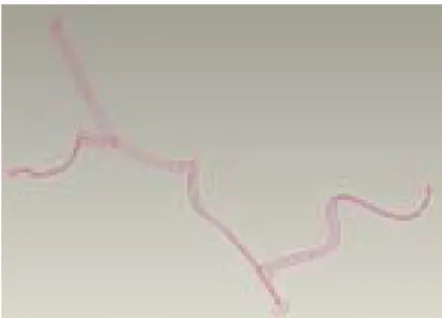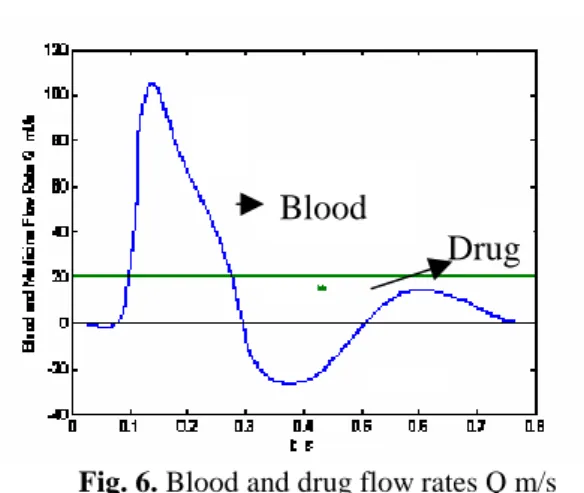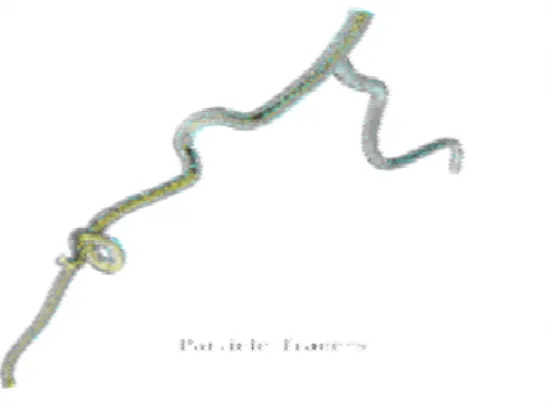行政院國家科學委員會專題研究計畫 成果報告
肝栓塞 TACE 手術後之血動力研究
計畫類別: 個別型計畫 計畫編號: NSC92-2218-E-002-026-YF 執行期間: 92 年 08 月 01 日至 93 年 12 月 31 日 執行單位: 國立臺灣大學工程科學及海洋工程學系暨研究所 計畫主持人: 許文翰 報告類型: 精簡報告 報告附件: 國際合作計畫研究心得報告 處理方式: 本計畫可公開查詢中 華 民 國 93 年 12 月 9 日
肝栓塞 TACE 手術後之血動力研究
Liver Hemodynamic studies on after patient’s hepatic transarterial
chemoembolisation (TACE)
執行期間:92 年 8 月 1 日至 93 年 12 月 31 日
計劃編號:92-2218-E-002-026-YF
計劃主持人:許文翰 國立台灣大學工程科學及海洋工程系所 教授
Abstract
Trans Arterial Chemo Embolisation (TACE) has been developed for liver tumor patients who can't be treated by invasive resection. In TACE, the chemotherapectic drugs are placed at the tumor location by the way of catheter. The tumors needed oxygen and nutrients are thus deprived and can eventually cause the cells to die very quickly. It is, therefore, important to estimate factors that may affect the placement of chemetherapatic drugs properly in the TACE surgery. In order to make sure the chemotheratpatic drugs won’t kill cells other than tumor, a 3D finite-volume model for two liver tumor surgery is presented and discussed.
1. Introduction
In Taiwan, the second leading death is associated with liver cancer which kills more than 7000 people per year. In the world, over one million patients die of primary and metastatic malignancies annually. While surgical resection is still the current choice for well-localized primary and metastatic hepatic malignancies, some patients may not be suitable for surgical resection because of the multifocal disease, tumor size and location. Thus, other surgical operations have been developed for patients who can't be treated by invasive resection. Trans Arterial Chemo Embolisation (TACE) is a minimally invasive treatment for cure of hepatic malignancies without losing the entire segments or lobes of normal liver. The procedure TACE involves, as schematic in Fig. 1, inserting thin catheters in small incisions of the femoral artery in the thigh.
The surgeon snakes the catheter through the arterial network to the problem area [1,2]. For a better navigation and positioning of the catheter, surgeons rely heavily on x-rays to have a snapshot of the arterial system as they manually push and pull the catheter in the network of blood vessels. This study is motivated to provide a prototype for TACE in blocking the tumor artery by chemotherapy drugs.
Fig.1 Schematic of TACE surgery
2. Numerical Model
Simulation of blood flow in liver artery involves solving the unsteady Navier-Stokes equations (1)-(2) for drug and blood transport in the TACE surgery.
0 Re* 1 ) ( 2 = ∂ ∂ ∂ ∂ ∂ + ∂ ∂ − = ∂ ∂ + ∂ ∂ i i m m i i m i m m x u x x u x p x u u t u
The three dimensional domain of interest is featured with a curved tube (Catheter) placed inside a hepatic artery and the tumor branch. The geometry consists of a hepatic artery diameter of 4mm (outer cylinder) and 3 mm catheter (inner cylinder). The entry flow is assumed to develop fully with a flow rate of 400 ml/min. The blood density and
Liver Portal Vein Catheter Pathway Hepatic artery (1) (2)
viscosity are taken as 1.059g/cm3 and 0.3 Psi Sec, respectively. It is assumed that the velocity at the inlet is 40 cm/sec along with the constant pressure 100mmHg.
In a TACE treatment, a cytotoxic agent such as doxorubicin or cisplatin is mixed with the radio-opaque iodized oil (Lipiodol) and injected into the artery. The iodized oil serves as a vehicle to carry the cytotoxic agent to the tumor and also as the embolizing agent that can block the tumor's vessels. The viscosity and density for the drug under current investigation are approximately taken to be 5 times of the blood. Usually there are three appropriate terminating positions as schematic in Fig. 2 for the catheter placement. In the National Taiwan University Hospital, the catheters of 6-3Fr (3Fr =1 mm) and 4 Fr are frequently used. The micro catheters (1Fr) along with the above millimeter catheters are used to reach the tumor feeding vessel as close as possible.
Fig.2 Schematic of three catheter placement locations
3. Numerical Methods
The CT angiography slices that include geometry information for the axis and cross section of liver artery are provided by National Taiwan University hospital as shown in Fig. 3. By virtue of this image data, the segmented cross section and axis of liver artery are generated using TGS-AMIRA schematic in Fig. 4. Mesh generation is performed using the commercially available software.
Fig. 3. The hepatic CT angiography data (Courtesy
from National Taiwan University Hospital)
Fig. 4 Schematic of the segmented cross section and
axis of liver artery
4. Results and Discussion
The simulated blood flow characteristics in an artery with or without catheter, as shown in Fig. 5, are discussed in detail in this section. The flow with its rate schematic in Fig. 6 is simulated at different density and viscosity in the artery and catheter. It is found that when the blood density is greater than drug density, the flow in the artery suppress the drug flow.
Fig.5 Schematic of the liver artery model without and
with catheter 1st 2nd 3rd 1. Celiac trunk 2. Left gastric artery 3. Common hepatic artery 4. Gastro- duodenal artery 5. Right gastric artery 6. Proper hepatic artery 7. Left hepatic artery Catheter
Fig. 6. Blood and drug flow rates Q m/s The artery pressure as depicted in Fig.7 reveals that at the lower end of the bifurcated artery has much lower pressure value than the inflow artery. Due to the high inlet velocity, there can be a higher pressure at the inlet. Normally the tumor is seen at the end of the artery with the lower pressure. Hence tumors get the blood from higher pressure artery. As seen in Fig. 7 the pressure decreases towards the downstream side. The blood flow is traced by the seeded particles as shown in Fig.89. It is observed that due to the pressure variations the particles are seen to flow towards the downstream direction. Here the normal hepatic artery blood pressure is seeded at the inlet.
This paragraph deals with the blood and drug flow with the presence of the catheter inside the hepatic artery, which is of our main interest. As the velocity of the drug is taken to be five times higher than that of the blood flow, there is no change in the mass flow rate of the drug flow. Due to the presence of bifurcations, the flow rate of blood changes dramatically. This evidence is schematic in Fig.9.
Fig. 7. Schematic of the artery pressure
Fig. 8 Particle tracers
In the presence of catheter, the blood and medicine flow paths are shown in Fig.9. As the drug flow velocity is five times greater than the blood flow, it sweeps the blood along with it. More analysis is needed to perform for better understanding the feature with various velocities between the blood and drug flow. If the drug flow velocity is less than the blood, then it can be seen that the drug is carried slowly along with blood. Also the streamlines can be compressed by the blood flow due to pressure variation in the drug and blood.
Fig. 9. Schematic of blood and drug flow In the current study, we considered the drug flow velocity is five times higher than the blood. Hence the higher pressure is observed at the inlet as shown in Fig.10. Due to pressure and velocity variations at the inlet of the catheter and outlet of the artery, the particle tracer (drug) shown in Fig.11 is observed to flow in equal directions at both sides of the bifurcated artery.
Drug Blood
Fig. 10. The simulated artery-catheter pressure
Fig. 11. The simulated drug article tracer
Acknowledgment
The present study is financially supported by 92-2218-E-002-026-YF.
References
[1] C Bartolzzi, R Lencioni, D Caramella, C Vignali, R Cioni, S Mazzeo, M Carrai, G Maltinti, A Capria and PF Conte: Treatment of large HCC:
transcatheter arterial chemoembolization combined with
percutaneous ethanol injection versus repeated transcatheter arterial chemoembolization, Radiology, Vol 197, 812-818
[2] S. Meier, P. Mildenberger, A. Schenk, H. Bourquain, P. Raab, M. Pitton, F. Schweden, H.-O. Peitgen, M. Thelen: Computer-assisted diagnostic follow-up of the treatment of hepatocellular carcinoma with TACE, European Congress of Radiology, Vienna, March 2003.


